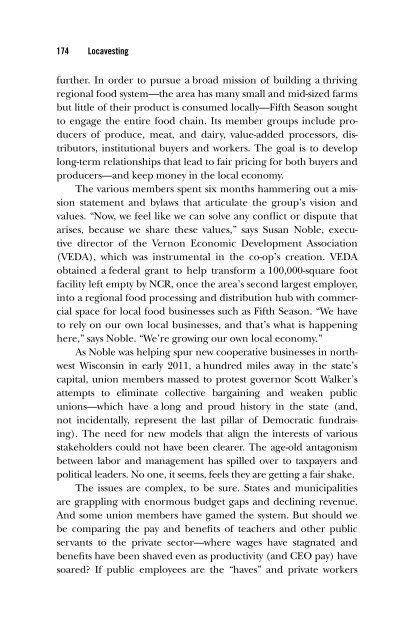3c hapter - Index of
3c hapter - Index of
3c hapter - Index of
Create successful ePaper yourself
Turn your PDF publications into a flip-book with our unique Google optimized e-Paper software.
174 Locavesting<br />
further. In order to pursue a broad mission <strong>of</strong> building a thriving<br />
regional food system—the area has many small and mid- sized farms<br />
but little <strong>of</strong> their product is consumed locally—Fifth Season sought<br />
to engage the entire food chain. Its member groups include producers<br />
<strong>of</strong> produce, meat, and dairy, value- added processors, distributors,<br />
institutional buyers and workers. The goal is to develop<br />
long- term relationships that lead to fair pricing for both buyers and<br />
producers—and keep money in the local economy.<br />
The various members spent six months hammering out a mission<br />
statement and bylaws that articulate the group’s vision and<br />
values. “Now, we feel like we can solve any confl ict or dispute that<br />
arises, because we share these values,” says Susan Noble, executive<br />
director <strong>of</strong> the Vernon Economic Development Association<br />
(VEDA), which was instrumental in the co-op’s creation. VEDA<br />
obtained a federal grant to help transform a 100,000-square foot<br />
facility left empty by NCR, once the area’s second largest employer,<br />
into a regional food processing and distribution hub with commercial<br />
space for local food businesses such as Fifth Season. “We have<br />
to rely on our own local businesses, and that’s what is happening<br />
here,” says Noble. “We’re growing our own local economy.”<br />
As Noble was helping spur new cooperative businesses in northwest<br />
Wisconsin in early 2011, a hundred miles away in the state’s<br />
capital, union members massed to protest governor Scott Walker’s<br />
attempts to eliminate collective bargaining and weaken public<br />
unions—which have a long and proud history in the state (and,<br />
not incidentally, represent the last pillar <strong>of</strong> Democratic fundraising).<br />
The need for new models that align the interests <strong>of</strong> various<br />
stakeholders could not have been clearer. The age- old antagonism<br />
between labor and management has spilled over to taxpayers and<br />
political leaders. No one, it seems, feels they are getting a fair shake.<br />
The issues are complex, to be sure. States and municipalities<br />
are grappling with enormous budget gaps and declining revenue.<br />
And some union members have gamed the system. But should we<br />
be comparing the pay and benefi ts <strong>of</strong> teachers and other public<br />
servants to the private sector—where wages have stagnated and<br />
benefi ts have been shaved even as productivity (and CEO pay) have<br />
soared? If public employees are the “haves” and private workers
















